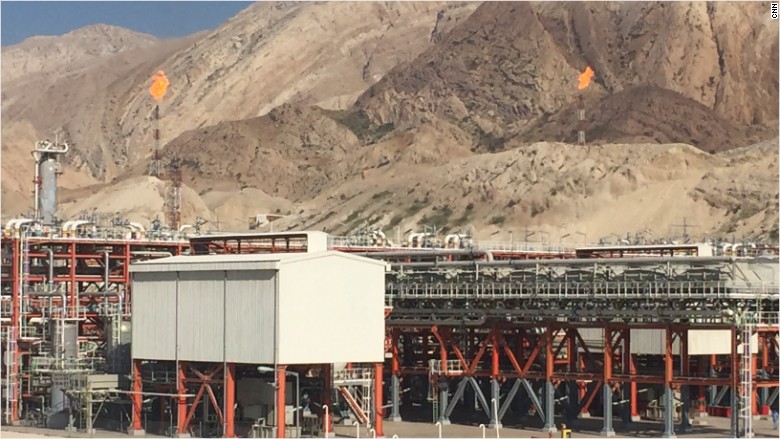
Flying into the Iranian town of Assaluyeh on the Persian Gulf, the first thing that sticks out during the approach is several large gas flames towering over a gigantic complex.
This is South Pars, home to Iran's biggest and most ambitious energy project, which is gaining momentum despite the headwinds in global oil and gas markets.
While many of Iran's oil and gas facilities are outdated and in dire need of investment, South Pars is a model of how the country would like its hydrocarbon sector to be viewed in the future: modern, efficient and productive.
The zone is divided into various projects, which the Iranians call phases. Phases 15 and 16, a refining complex, were completed only a few weeks ago. Posters of President Hassan Rouhani, who came to the inauguration of the facilities, still stand in front of gas storage tanks and a maze of pipes and valves used in the refining process.
"This plant uses the latest technology. We only use the most high-tech methods in this plant," says Reza Forouzeh, the project manager for phases 15 and 16.
Two pipelines from the Persian Gulf feed crude gas and gas condensate into the refinery. Maintenance crews constantly work to fix minor leaks, but the equipment here is brand new and barely needs servicing.
Related: Iran wants to buy planes, resume U.S. flights
"We have no problem with the equipment, just minor issues," maintenance engineer Siavash Vahidi says. "For example, changing the gaskets and some repairing activity on the pumps."
South Pars is the largest gas field in the world, holding some 1,800 trillion cubic feet of reserves. It's shared between Iran and Qatar.

Iran decided to exploit its part of the reserves in the early '90s, but activity at the Assaluyeh complex was often hampered, especially during the years that former President Mahmoud Ahmadinejad was in power.
"For me, the biggest challenge was dealing with the sanctions," says Hamid Reza Medhavi, the project manager for phases 20 and 21, where thousands of workers are busy linking pipes and installing electronic equipment to control and monitor refining processes.
Medhavi says improvisation skills helped the engineers overcome the shortages, especially of specialized equipment.
Related: Iranian president does big business in Europe
"We found solutions for each problem we faced regarding the sanctions," he says. "And you can see that in a little more than five years, we have built this big plant. This is a $4.5 billion project. We have done it even thought the sanctions were very tough."
Now that most of the sanctions have been lifted, those in charge of South Pars want to accelerate the construction of the refineries in spite of low international oil and gas prices.
Analysts say that Iran's hydrocarbon strategy is about more than revenue, it's also about geopolitical power. Tehran is aiming to become one of the largest producers in the world.
The managing director of the Pars Oil and Gas Company, Ali Akbar Shabanpour, says he believes the benefits of sanctions relief will lie mostly in easier access to sophisticated equipment, mainly from Europe.
Related: Iran says it's planning for economic boom
Under the sanctions regime, Iran had to acquire high-end turbines, compressors and other goods through middlemen because they were not allowed to officially purchase them from the manufacturers.
"Delivery will be much more easy," Shabanpour says. "At the beginning, we will need the assistance of the vendors, and that will be much easier to get because we will have quick access to them."
But he is quick to add that the majority of contracts will still go to Iranian companies, which he says have built up a great deal of expertise by filling the gap left by international firms that were forced to leave after sanctions were imposed.
"We get more than 65%, maybe even around 70% of our material from Iranian manufacturers," he said.
Now that most of the sanctions against Tehran have been lifted, Iran is poised to become one of the biggest exporters of oil and gas in the world. The South Pars gas field and this huge refining complex are key to the country's future hydrocarbon strategy.


